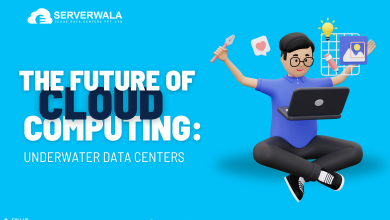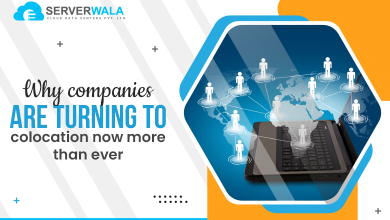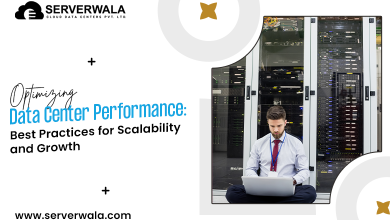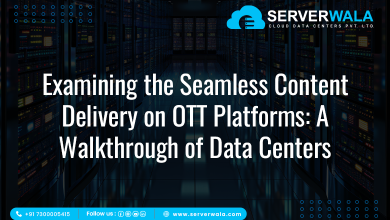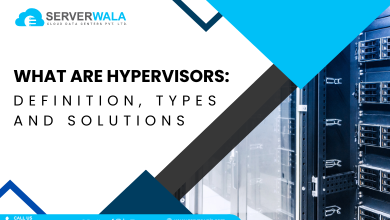Building Contemporary Data Centre Architecture
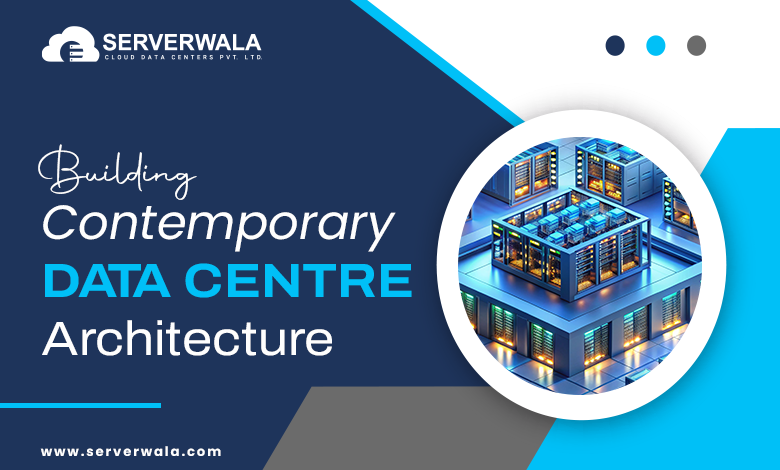
Introduction
In today’s digital-first era, data centers are the linchpins of global industries, supporting everything from real-time financial transactions to the seamless streaming of high-definition content. These facilities underpin critical operations across e-commerce, IoT, cloud computing, and AI. As digital reconfiguration advances, the demand for high-performing, reliable, and scalable data center architectures has skyrocketed.
The restrictions of traditional data centers are turning out to be evident. Rising workloads, fluctuating demands, and the need for continuous uptime require a fresh approach to infrastructure. Modern data centers have evolved to address these challenges, emphasizing sustainability, adaptability, and advanced technological integration. This blog digs into the transformation of data center design and architecture. It highlights key trends like energy optimization, modularity, and the incorporation of intelligent systems that enable unparalleled operational efficiency. The article also explores the critical role of renewable energy sources, advanced cooling solutions, and hybrid infrastructures in reducing operational costs and environmental impact.
By adopting these innovations, businesses can build data centers that not only address today’s challenges but also prepare for future needs. The modern data center is designed to accommodate exponential growth, manage complex workloads, and deliver superior performance. The focus is on reducing carbon footprints, maximizing energy efficiency, and leveraging automation to fulfiill the necessities of a data-driven globe. As organizations embrace these cutting-edge designs, they position themselves for resilience and agility in an ever-evolving digital landscape. This shift isn’t just about keeping pace with technological advancements—it’s about building the foundation for sustained innovation and growth.
Design Development for Data Centres
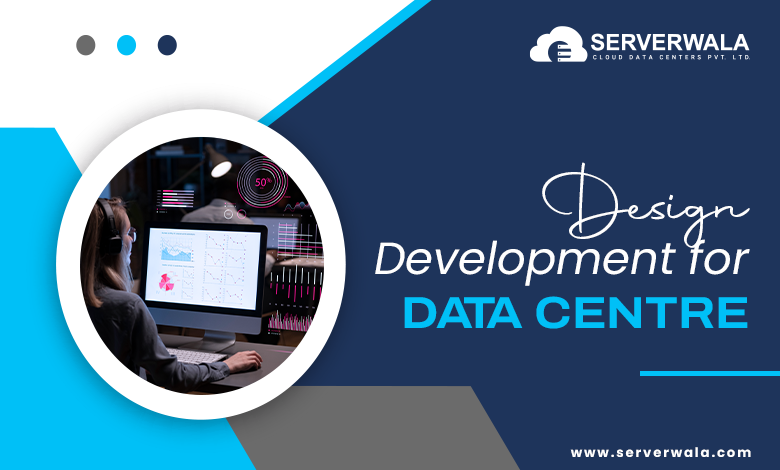
Modern data center design is an intricate process. It begins with a deep understanding of organizational requirements, focusing on capacity, performance, and future scalability. The design must align with business goals, operational needs, and industry regulations. Below are key aspects that define the development of contemporary data centers:
Key Considerations for Design Development
- Location Selection
- Proximity to users ensures low latency, vital for industries such as finance, e-commerce, and healthcare.
- Geographically stable areas reduce risks from natural disasters like earthquakes or floods.
- Access to renewable energy sources helps minimize carbon footprints as well as sync with sustainability objectives.
- Reliable network connectivity and energy infrastructure are non-negotiable prerequisites.
- Scalability and Modularity
- Modular Designs: Enable the addition of capacity (power, storage, or cooling) without major disruptions.
- Prefabricated Data Centers: Accelerate deployment timelines and reduce construction complexity.
- Scalable architecture ensures the data center grows alongside the business, avoiding overbuilding.
- Energy Efficiency
- Cooling Innovations: Traditional air cooling is being replaced or supplemented by liquid cooling, immersion cooling, and AI-powered systems that adapt to heat fluctuations.
- Energy Use Optimization: Smart sensors monitor power consumption, enabling precise energy allocation.
- Adoption of renewable energy sources such as solar and wind reduces operational costs as well as environmental infleunce.
- Deployment of Power Usage Effectiveness (PUE) metrics to measure energy efficiency and benchmark improvements.
- Enhanced Security Measures
- Physical Security: Includes biometric access controls, 24/7 surveillance, and anti-tailgating systems to prevent unauthorized access.
- Cybersecurity: Advanced firewalls, real-time threat detection systems, and AI-powered predictive analytics defend against evolving cyber threats.
- Separation of sensitive systems ensures minimal impact during security breaches or failures.
- Technology Integration
- AI and Machine Learning: Automate performance monitoring & fine-tune resource allocation.
- Software-Defined Infrastructure: Enables flexibility in network, storage, and compute management.
- Edge Computing: Places servers closer to end-users, lessening latency as well as intensifying real-time processing.
- Sustainability Initiatives
- Data centers are now incorporating sustainable building materials and designs.
- Use of heat recycling technologies to redirect waste heat for nearby residential or industrial use.
- Green certifications like LEED or BREEAM ensure adherence to environmental standards.
- Resilience and Redundancy
- Backup Systems: Includes redundant power supplies, battery systems, and failover mechanisms to ensure uptime.
- Disaster Recovery Plans: Ensure quick recovery in the situation of an outage or natural calamity.
- Testing and Simulation: Regularly test fault-tolerance systems to validate preparedness.
Cooling System Innovations
Cooling systems have seen revolutionary advancements. Traditional air-based systems are being replaced with efficient solutions such as:
- Liquid Cooling: Transmits heat more efficiently than air, enabling higher server densities.
- Immersion Cooling: Submerges equipment in non-conductive fluids, significantly reducing energy costs.
- AI-Powered Climate Control: Adapts cooling dynamically based on server loads and environmental conditions.
Components of Contemporary Data Centre Design
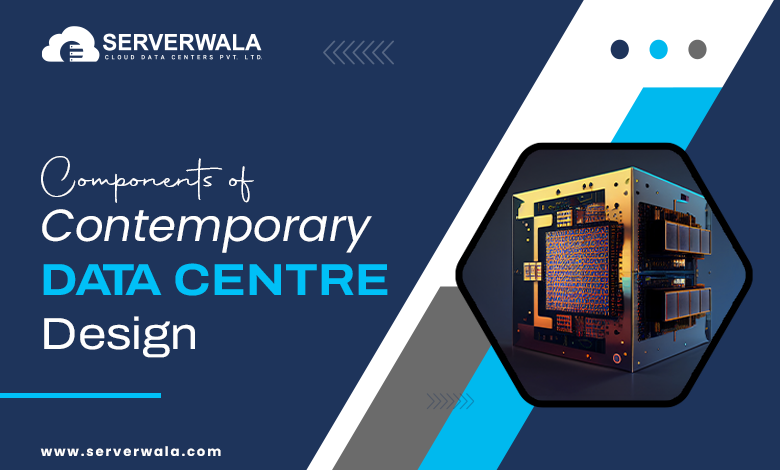
Modern data centers are engineered to meet the growing demands of a data-driven world. They incorporate cutting-edge technologies and sustainable practices to render unmatched functioning, dependability, and scalability. Following is an exhaustive exploration of the essential components that define contemporary data center architecture:
1. Power Systems
Power infrastructure is the lifeline of a data center. It ensures uninterrupted operations and minimizes energy wastage.
- Redundant Power Supplies:
- Dual power feeds, UPS, and diesel or gas generators ensure uptime during power outages.
- Redundancy is critical for Tier III and Tier IV data centers, where uptime requirements exceed 99.9%.
- Energy Efficiency Initiatives:
- High-efficiency transformers and high-voltage direct current (HVDC) systems reduce power conversion losses.
- Power distribution units (PDUs) with aligned energy monitoring enhance visibility into energy use.
- Renewable Energy Integration:
- Solar panels, hydroelectric power, and wind turbines reduce dependence on fossil fuels.
- Enterprises such as Microsoft, Google, etc., are leveraging 100% renewable energy for their data centers.
- Battery Storage Systems:
- Lithium-ion batteries provide reliable energy storage with a smaller footprint and longer life span compared to lead-acid batteries.
- Emerging solid-state battery technologies promise improved safety and efficiency.
2. Cooling Solutions
Efficient cooling is vital to managing the heat constructed by high-density computing platforms. Advanced cooling systems focus on reducing energy use while maintaining optimal performance.
- Liquid Cooling:
- Circulates liquid directly to server components, providing superior heat dissipation.
- Reduces the need for energy-intensive air conditioning, making it apt for high-performance computing.
- Immersion Cooling:
- Put servers in dielectric fluids that takes up and dissipate heat efficiently.
- Offers significant energy savings and allows for higher server density.
- AI-Powered Climate Control:
- Machine learning algorithms adjust cooling dynamically based on real-time workloads and environmental factors.
- Improves energy efficiency by predicting and preventing thermal hotspots.
- Free-Air Cooling:
- Leverages ambient air in cooler climates to reduce dependability on mechanical cooling systems.
- Popular in regions with stable and predictable weather conditions.
- Hot and Cold Aisle Containment:
- Physically separates hot exhaust air from cold intake air to prevent mixing, improving cooling efficiency.
3. Network Infrastructure
Fast and reliable network infrastructure is at the core of any modern data center. It ensures seamless data transfer, low latency, and high availability.
- Fiber Optic Connectivity:
- Enables ultra-fast data transfers over greater distances with the least latency.
- Essential for cloud computing and global connectivity.
- Software-Defined Networking (SDN):
- Renders centralized adminstration over network resources, enabling flexibility and automation.
- Eases up network maintenance and permits for quicker response to dynamic workload requirements.
- 5G and Edge Integration:
- Supports emerging use cases such as IoT, AR, and independent vehicles.
- Ensures data is processed closer to the end-user for real-time responsiveness.
- High-Density Cabling Systems:
- Organize network connections efficiently while supporting scalability.
- Minimize signal interference for consistent performance.
4. Storage Solutions
Modern data centers must handle vast amounts of structured and unstructured data. Storage solutions prioritize scalability, performance, and integration.
- Cloud-Integrated Storage:
- Combines on-premises storage with public and private cloud environments for hybrid data management.
- Ensures flexibility in data accessibility and disaster recovery.
- Edge Storage:
- Positions storage closer to users or IoT devices, reducing latency and bandwidth usage.
- Facilitates real-time data analysis for applications like smart cities and industrial automation.
- Non-Volatile Memory Express (NVMe):
- Delivers high-speed storage performance, crucial for data-intensive tasks such as AI training and big data analytics.
- Automated Storage Tiering:
- Moves frequently accessed data to faster storage tiers and less critical data to cost-effective solutions.
- Optimizes cost and performance by aligning storage needs with business priorities.
5. Security Measures
Data centers face constant threats, making powerful protection a formost priority. Both physical and digital defenses are critical.
- Physical Security:
- Advanced systems like biometric access controls (facial recognition, retina scans) ensure only authorized personnel enter sensitive areas.
- Anti-tailgating doors, mantraps, and perimeter fencing add additional layers of protection.
- Round-the-clock monitoring with AI-driven video surveillance detects and alerts unusual activities.
- Cybersecurity:
- AI-powered threat detection systems identify and neutralize potential risks in real time.
- Strong encryption standards protect data during transit and storage.
- Multi-layered firewalls and intrusion detection systems (IDS) safeguard networks against malicious attacks.
- Regular penetration testing and vulnerability assessments keep defenses up-to-date.
6. Monitoring and Automation
Automation tools enhance efficiency and minimize human error by rendering real-time insights into functioning.
- Data Center Infrastructure Management (DCIM):
- Offers a unified dashboard for monitoring power, cooling, and space utilization.
- Facilitates predictive maintenance by identifying possible problems before they elevate.
- IoT Sensors:
- Look over environmental conditions such as airflow, humidity, etc.
- Provide granular data to optimize functioning as well as energy utilization.
- AI and Machine Learning:
- Predict component failures and recommend proactive maintenance.
- Optimize resource allocation based on historical trends and real-time metrics.
Also Read: Advantages of Data Center Leasing
Modern Data Centre Design Shifts
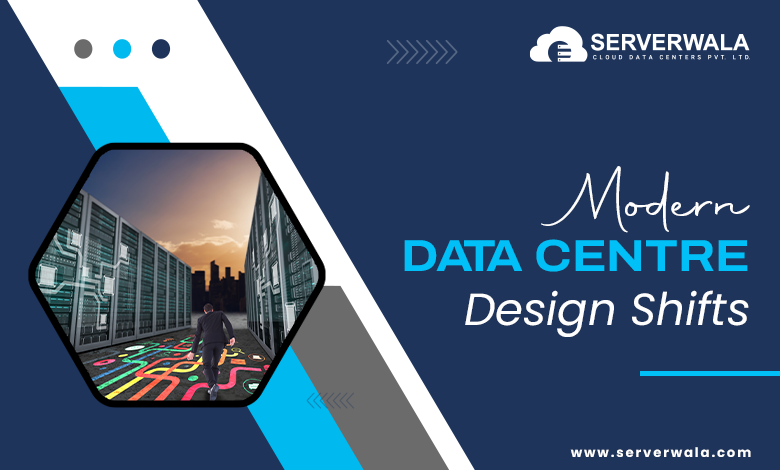
The evolution of data center design mirrors the rapidly changing demands of a data-driven world. With businesses relying heavily on digital infrastructure for daily operations, these facilities have undergone a transformation to deliver efficiency, scalability, and adaptability. Below is a detailed exploration of the key design shifts shaping modern data centers.
Sustainability
Sustainability has cope up as a base of modern data center design, driven by environmental concerns and rising operational costs. These facilities are now designed to minimize energy consumption and reduce their carbon footprint.
- Renewable Energy Integration:
Many data centers now operate on renewable energy sources, for instance, wind, hydroelectric power, etc. Companies like Microsoft and AWS have pledged to achieve 100% renewable energy operations by 2030. The global shift towards green energy has seen over 60% of new data centers incorporating renewable energy into their power systems in 2023. - Energy-Efficient Hardware:
Modern servers and storage systems are built with energy-efficient components, such as ARM-based processors and solid-state drives, which consume less power. Progressive techniques such as dynamic voltage & frequency scaling (DVFS) further optimize power usage, particularly during low workloads. - Cooling Innovations:
Cooling accounts for a significant part of a data center’s energy usage. Innovative solutions, such as liquid immersion cooling and free-air cooling, have reduced cooling costs by as much as 40%. These methods use ambient air or liquid to dissipate heat more effectively than traditional air conditioning. - Waste Reduction:
Data centers are adopting modular construction to reduce material waste during building phases. Additionally, recycling programs for obsolete hardware ensure components are repurposed or safely disposed of, minimizing environmental impact.
Edge Computing
The evolution of edge computing has introduced a paradigm shift in data center architecture. By positioning smaller, decentralized facilities closer to users, edge computing lessens latency and intensifies real-time processing.
- Latency Reduction:
Proximity to users allows data to travel shorter distances, reducing latency from tens of milliseconds to under 5 milliseconds. This is vital for latency-sensitive apps such as telemedicine, autonomous vehicles, and augmented reality. - Distributed Infrastructure:
Edge data centers are compact and modular, allowing for rapid deployment in urban or remote areas. These centers handle localized data processing, reducing the strain on larger, centralized facilities. - Supporting IoT:
The proliferation of IoT devices has fueled the necessity for edge computing. By 2025, IoT is expected to construct over 79 zettabytes of data every year. Edge data centers perform a significant part in managing this influx by enabling real-time analytics and processing.
Automation
Automation has become a game-changer in modern data center management, enhancing efficiency and reducing operational complexity.
- AI-Driven Operations:
Artificial intelligence as well as machine learning technologies are used to optimize data center performance. For example, AI can predict system failures, allocate resources dynamically, and manage cooling systems more efficiently. Google has successfully reduced its cooling energy consumption by 30% through AI-driven optimization. - Self-Healing Systems:
Automation extends to maintenance, where systems can recognize as well as fix problems without human interference. These self-healing mechanisms reduce downtime and improve overall reliability. - Predictive Analytics:
Advanced analytics tools monitor system functioning and identify anomalies before they evolve into big problems. This active strategy guarantees hassle-free operations and minimizes disruptions.
Resilience
Resilience is a critical focus in data center design, ensuring facilities can withstand disruptions and maintain continuous operations.
- Redundancy:
Modern data centers incorporate redundant systems for cooling, networking, and power to discord individual points of failure. Tier IV data centers, for instance, offer 99.995% uptime, translating to less than 26 minutes of downtime annually. - Disaster Recovery:
Advanced disaster recovery strategies include real-time data replication as wel as automated failover platforms. These systems switch operations to backup facilities instantly in the situation of interruptions, guaranteeing business continuity. - Enhanced Cybersecurity:
Cyber resilience is achieved through multi-layered security measures. These include real-time threat detection systems, encryption, and zero-trust architecture. In 2023, over 85% of enterprises prioritized cyber resilience as a key focus in their data center operations.
Hybrid Models
Hybrid data center architectures blend on-premises, cloud, and edge solutions to create a flexible and scalable environment.
- Workload Optimization:
Hybrid models allow businesses to assign workloads as per their particular necessities. Sensitive data can be kept on-premises for enhanced security, while less critical tasks leverage the scalability of cloud platforms. - Cost Efficiency:
Combining different infrastructures reduces operational costs by optimizing resource allocation. Hybrid models also eliminate the need for over-provisioning resources, which is common in traditional data centers. - Unified Management:
Modern tools enable seamless integration and management of hybrid environments. Businesses can monitor and control resources across on-premises, cloud, and edge facilities from a single interface.
Also Read: How to achieve high availability with data center redundancy?
To Put It All Together
The evolution of data center architecture is a testament to the intersection of innovation and necessity. Modern data centers are no longer mere storage facilities; they are ecosystems designed to power the digital future. This transformation prioritizes flexibility, scalability, and efficiency to fulfill the modifying demands of businesses of varied industries.
Sustainability lies at the core of these architectures. By embedding renewable energy sources as well as optimizing power consumption, organizations can drastically lessen their carbon footprint. In 2023 alone, over 40% of new data centers implemented renewable energy solutions, reflecting a clear shift towards eco-friendly practices. These investments mitigate environmental impact as well as help you gainlong-term cost savings.
Cutting-edge technologies like AI-powered automation and liquid immersion cooling redefine operational performance. Automation reduces the risk of human error, fine-tune resource allocation, and intensifies system resilience. Cooling innovations ensure energy consumption is minimized while maintaining optimal conditions for high-performance hardware.
Modern designs also emphasize security and resilience. Advanced cybersecurity measures, including AI-based threat detection, encryption protocols, and zero-trust architectures, safeguard sensitive data from evolving threats. Simultaneously, robust disaster recovery plans and fault-tolerant systems ensure uninterrupted operations during outages or crises. On the other hand, modularity and scalability are crucial for future-proofing. Modular designs allow businesses to expand or upgrade facilities without major disruptions, enabling seamless adaptation to changing needs. As global data usage continues to grow—projected to reach 175 zettabytes by 2025—this flexibility is more important than ever.
Adopting contemporary data center architectures is more than an operational upgrade. Businesses that embrace these innovations position themselves as leaders in a competitive arena. They gain the dexterity to respond to market modifications, the power to withstand disruptions, and the sustainability to align with global environmental goals. Ultimately, the modern data center is more than infrastructure—it’s a strategic enabler of progress, powering industries, innovation, and the digital future. By building adaptable, energy-efficient, and secure environments, organizations lay the groundwork for sustained growth and transformation.

